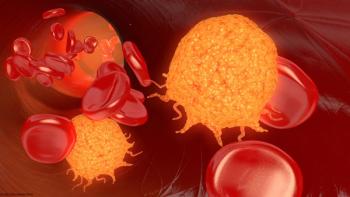
177Lu May Be a ‘Good Choice’ for Pretreated Metastatic Prostate Cancer
Clinical trials highlight benefits, including radiographic progression-free survival following treatment with radioligand 177Lu-PSMA-617 in pretreated patients with metastatic castration-resistant prostate cancer.
At the
Tagawa, a professor of medicine and urology and medical director of the Genitourinary Oncology Research Program at Weill Cornell Medicine, described the radiographic progression-free survival (rPFS) and overall survival (OS) benefits observed with 177Lu-PSMA-617 in the phase 3 VISION study (NCT03511664) that led to the agent becoming
Transcript:
Bringing in the second approved radionuclide [177Lu-PSMA-617], that also leads to a survival advantage. Except [177Lu-PSMA-617] more directly targets the tumor, so it directly targets PSMA, and PSMA aside from other normal organs in the body, is also on tumors. So, this radionuclide is a beta emitter rather than an alpha like radium-223, but it more directly targets the tumors. And thus, we can actually see a response. Patients like to see their PSA go down and then see shrinkage on scans, so it was nice to have that.
And [177Lu-PSMA-617] in combination with other ongoing trials are really leading to disruptions in the treatment paradigm. Not so much just with initial approval. The phase 3 VISION study was in pretreated patients. The design was very similar to the phase 3 ALSYMPCA radium-223 trial [NCT00699751]. [Patients received] best standard of care limited by the protocol, which is mostly hormone therapy, steroids, or external radiation, with or without 177Lu-PSMA-617. And that led to a prolongation in radiographic progression-free survival as well as overall survival, both of the dual end points.1 That’s the main study that led to the approval of this agent.
That was done in parallel with a randomized phase 2 study called TheraP (NCT03392428) which was an Australian and New Zealand cooperative study. Unlike the VISION trial, it went head-to-head with a very active agent in cabazitaxel [Jevtana]. Basically, that trial was positive on all ends.2 The primary end point was a PSA 50% response, and that was positive. Also, most of the other end points were positive, including differences—not necessarily improvements—in terms of toxicity. The response plus the adverse event profile translated to improvements in patient-reported outcomes, with no detriment in overall survival. Some people say that’s a negative overall survival, but it was a secondary end point, so I would just say no detriment.
Overall, for that highly-selective patient population with imaging, it’s just additional evidence that 177Lu-PSMA-617 might be a good choice, even when there’s another chemotherapy option that’s out there. They’re both good choices that depend on the individual patients and, unfortunately for the time being, availability of 177Lu-PSMA-617.
References
- Morris MJ, De Bono JS, Chi KN, et al. Phase 3 study of lutetium-177-PSMA-617 in patients with metastatic castration-resistant prostate cancer (VISION). J Clin Oncol. 2021;39(suppl 15):LBA4. doi:10.1200/JCO.2021.39.15_suppl.LBA4
- Hofman MS, Emmett L, Violet J, et al. TheraP: a randomized phase 2 trial of 177 Lu-PSMA-617 theranostic treatment vs cabazitaxel in progressive metastatic castration-resistant prostate cancer (Clinical Trial Protocol ANZUP 1603). BJU Int. 2019;124 (suppl 1):5-13. doi:10.1111/bju.14876
Newsletter
Stay up to date on recent advances in the multidisciplinary approach to cancer.


















































































